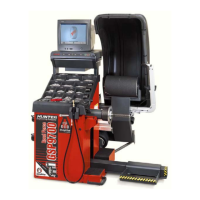GSP9700 Series Road Force Measurement System Operation 8. Theory of Operation 137
is unpredictable and unfavorable for shops charging flat rates and for customers
paying for labor by the hour.
While the StraightTrak
®
function should not replace fundamental diagnostic
procedures, such as visual inspection of tread wear, inspection for brake drag,
measurement of tire pressure and ride height, suspension check, alignment, and test
driving, StraightTrak
®
has the potential to dramatically reduce the number of trial
configurations and test drives.
What can be accomplished with StraightTrak
®
LFM?
Elimination or reduction of tire related drift/pull
Superior ride quality from increased vehicle straight-ahead stability
Prevention of problems or comebacks after rotations
Enhancement of steering stability and reduction in wandering
Reduction of driver fatigue due to pull
When should StraightTrak
®
LFM be used?
Tire mounting and balancing processes
Tire rotations
Alignment services
How is StraightTrak
®
LFM used?
Determine minimum lateral force offset on a steer axle to
reduce/eliminate tire related pull conditions. The “least net tire pull” in
most cases will yield the best results.
Diagnose residual pull symptoms with a road test. (In this case, the
original placement of the tires and the associated tire net pull is important
to use in order to determine the amount of offset on the new placement.)
The “least net tire pull” placement may not be the best choice and in
some cases “alternate placement” choices can be used to counteract
other variables causing the vehicle to pull. Refer to “Show Least Pull,”
page 76.
Theory
Automotive and light truck tires produce a lateral (or axial) force when rolling on a flat,
smooth road. Lateral force is defined as the amount of directional side force
generated as the tire/wheel assembly rotates. The net sum difference in the lateral
force between the two front steer tires may cause a vehicle to steer away from a
straight line. Sources of lateral forces include tire conicity, ply steer, and other forces
known together as Total Lateral Force. Traditional wheel balancers and static wheel
alignment measuring systems cannot measure conditions caused by tire lateral
forces. The automotive service industry has long been aware of tire-related vehicle
lateral force conditions; however, no quantifiable method for diagnosis has existed for
the service shop.
With the StraightTrak® Lateral Force Measurement (LFM) feature, the Hunter
GSP9700 Series Road Force Measurement System can measure the primary lateral
forces generated by a rolling tire/wheel assembly. Using the load roller, it applies
radial loads of up to 1400 pounds to the tire. The corresponding lateral forces
produced between the tire and load roller are then measured. By rotating the
tire/wheel assembly both clockwise and counter-clockwise, the system can calculate
conicity values for a set of tires and then display net results from twelve possible tire
combinations on the steer axle. With this information, technicians can place tires to
minimize or eliminate pull. The Lateral Force measurement is automatically
performed during the normal Road Force measurement sequence.

